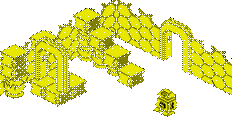Atari ST Technical Details and Trivia
 Connectors
Connectors
- RS-232C serial port (DB25 male)
- Centronics parallel port (DB25 female)
- 2 x MIDI ports (5-pin DIN, one for 'In' and one for 'Out/Through')
- 2 x joystick ports (DE9 male on Atari ST/STF/STFM, Enhanced Joystick Port on STE)
- Monitor port (custom 13-pin DIN, comprising signals for mono & colour monitor, mono audio, and in later models, composite video)
- ACSI hard drive port (custom 19-pin D-SUB)
- Cartridge port (40-contact edge connector, double-sided - supports up to 128K ROM cartridges)
 Technical Facts
Technical Facts
- The Yamaha YM2149F Programmable Sound Generator found in all ST's prior to the STe series placed a minimal amount of processing burden on the CPU, although this was only true of analog sound. For digital sound, the system slowed down significantly. Not until the STe was released in 1989 was this situation improved upon. The STe came with PCM audio capability, which meant it could produce CD-quality digital sound without taking much processing power from the CPU.
- The built-in floppy disk controller permitted up to two daisy-chained floppy disk drives, able to read 125Kbits per second on single-sided drives (360K disks), or 250 Kbits per second on double-sided drives (720K disks).
- Upon operation, the ST's graphics subsystem takes 32K of main RAM, reserving it for 'BitMap video display memory'. Later machines used a 'BLiTTER' chip to speed up filling operations (mainly to improve performance in GEM).
Hover your mouse over the circuit board for a description of the components

Note: The above PCB is a 520STFM board
Component details reproduced with friendly permission from Sothius' Home, www.sothius.com
 Trivia
Trivia
- The ST supported hard disk drives, such as Atari's own 'Megafile'.
- The ST actually supported PC-compatible 360K disk drives.









